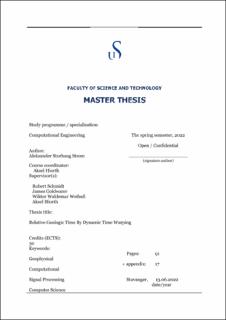| dc.description.abstract | This thesis considers an approach to tackle a core problem within seismic interpretation, which is bringing an autonomously generated interpretation of the seismic
data, which is now known as a Relative Geologic Time. The proposed method readily utilizes the method of Dynamic Time Warping, which is an established method
within signal processing. Using Dynamic Time Warping is thought to replicate similar interpretations an interpreter would conduct when fulfilling an interpretation of
the subsurface. Utilizing Dynamic Time Warping to seismic data results in a fully
autonomous interpretation of the subsurface, conducted in minutes and seconds. The
method is simple and extendable, which can easily be further expanded. The workflow established during the thesis work results in a method that successfully produces
an RGT volume. However, problems related to the method must be improved to
enhance the outcome further and diminish errors present in the result. Furthermore,
even with problems associated with the method, potential solutions are described in
detail in the discussion and appendix. Discussion affiliated with previous attempts
in solving Relative Geologic Time volumes is emphasized. The research conducted in
Dynamic Time Warping is promising and emits potential for further research. LaTeX
setup by Gunn and Patel (2017). | |
